Investigation of Tribological Behavior of PTFE Composites Reinforced with Bronze Particles by Taguchi Method
Abstract
:1. Introduction
2. Taguchi Method
3. Experimental Procedure
3.1. Materials
3.2. Test Samples Preparation
3.3. Tribological Tests
3.4. Design of Experiments
4. Results and Discussions
4.1. Analysis of Test Parameters
4.2. Analysis of Variance (ANOVA) Test
4.3. Friction and Wear Maps
4.4. Regression Analysis
4.5. Verification Test
- Material type: 60 vol% PTFE composite reinforced with bronze particles.
- Normal load: 50 N.
- Sliding speed: 1 m/s.
- Material type: 60 vol% PTFE composite reinforced bronze particles.
- Normal load: 100 N.
- Sliding speed: 0.32 m/s.
4.6. Wear Mechanism
5. Conclusions
- The addition of the bronze particles to the PTFE polymer as a reinforcement phase improves the tribological properties of the material.
- The material type is more pronounced on the desired wear resistance and COF rather than other parameters of the tribological system, such as normal load and sliding speed.
- Among the bronze-reinforced PTFE composites used in the study, PTFE composites reinforced with 60 vol% bronze particles showed the lowest specific wear rate, followed by PTFE + 40 vol% bronze particles included composite, and then PTFE + 25 vol% bronze particles included composite.
- The COF and SWR were found to be influenced by the material type (29.83% and 96.16%), the normal load (33.34% and 0.95%), and sliding speed (9.14% and 1.28%).
- The optimum wear test conditions at that the minimum COF and the lowest SWR were achieved to be A4B2C2 and A4B3C1 levels of the wear test parameters, respectively.
Author Contributions
Funding
Data Availability Statement
Conflicts of Interest
References
- Khedkar, J.; Negulescu, I.; Meletis, E.I. Sliding wear behavior of PTFE composites. Wear 2002, 252, 361–369. [Google Scholar] [CrossRef]
- Bijwe, J.; Neje, S.; Indumathi, J.; Fahim, M. Friction and wear performence evaluation of carbon fibre reinforced PTFE composite. J. Reinf. Plast. Compos. 2002, 21, 1221–1240. [Google Scholar] [CrossRef]
- Stankovic, M.; Vencl, A.; Marinkoviz, A. Tribological Properties of Self-Lubricating Sliding Bearings Made of PTFE and POM-Based Composite Materials. In Proceedings of the 13’th International Conference on Tribology, Kragujevac, Sirbia, 15–17 May 2013; pp. 314–318. [Google Scholar]
- Tevruz, T. Tribological behaviours of bronze-filled polytetrafluoroethylene dry journal bearings. Wear 1999, 230, 61–69. [Google Scholar] [CrossRef]
- Tevruz, T. Tribological behaviours of carbon filled polytetrafluoroethylene (PTFE) dry journal bearings. Wear 1998, 221, 61–68. [Google Scholar] [CrossRef]
- Yadav, S.M.; Budan, D.A.; Basavarajappa, S.; Mudasar Pasha, B.A.; Kumar, S. Studies on Wear Resistance of PTFE Filled with Glass and Bronze Particles Based on Taguchi Technique. J. Eng. Sci. Technol. Rev. 2012, 5, 26–29. [Google Scholar] [CrossRef]
- Sadaphal, N.D.; Bhosale, K.C.; Kharde, S.B.; Varade, H.P. Performance Behaviour of Composite Polytetrafluroethylene (PTFE)-A Taguchi Approach. Int. J. Curr. Eng. Technol. 2014, 3, 235–238. [Google Scholar]
- Gujrathi, S.M.; Dhamande, S.; Patare, P.M. Wear studies on polytetrafluoroethylene (PTFE) composites: Taguchi approach. Int. J. Ind. Eng. Manag. Sci. 2013, 3, 47–51. [Google Scholar]
- Patare, P.M.; Lathkar, G.S. Effects of Filler Glass Fiber on the Tribological Properties of PTFE Composites. Int. J. Innov. Res. Sci. Eng. Tech. 2014, 3, 17624–17631. [Google Scholar]
- Varade, B.V.; Kharde, Y.R. Prediction of Specific Wear rate of Glass Filled PTFE Composites by Artificial Neural Networks and Taguchi Approach. Int. J. Eng. Res. App. 2012, 2, 679–683. [Google Scholar]
- Varpe, S.G.; Mate, D.M. Comparative analysis for tribological behaviour of PTFE composite with different filler material. Int. J. Sci. Adv. Res. Technol. 2015, 1, 194–198. [Google Scholar]
- Chaudhari, S.B.; Shekhawat, S.P. Wear Analysis of Polytetrafluoroethylene (PTFE) and Its Composites under Wet Conditions. Int. Mech. Civ. Eng. 2013, 8, 7–18. [Google Scholar]
- Sahin, Y. Analysis of abrasive wear behavior of PTFE composite using Taguchi’s technique. COG Eng. 2015, 2, 1–15. [Google Scholar]
- Bagale, D.; Shekhawat, S.; Chaudri, J. Wear Analysis of Polytetrafluoroethylene and it’s Composites under Dry Conditions using Design-Expert. Int. J. Sci. Res. Pub. 2013, 3, 1–4. [Google Scholar]
- Maculotti, G.; Goti, E.; Genta, G.; Mazza, L.; Galetto, M. Comprehensive Mechanical and Tribological Characterization of Metal-polymer PTFE + Pb/Bronze Coating by in-situ Electrical Contact Resistance Measurement Augmented Tribo-mechanical Tests. Tribol. Int. 2024, 193, 109397. [Google Scholar] [CrossRef]
- Christian, O.; Tobias, R.; Stephan, T. Unveiling an additively manufactured open hardware pin-on-disc tribometer considering its high reproducibility. Wear 2024, 552–553, 205437. [Google Scholar]
- Rüstem, B. Experimental and machine learning comparison for measurement the machinability of nickel based alloy in pursuit of sustainability. Meas 2024, 236, 115142. [Google Scholar]
- Tao, S.; Peiping, Y.; Shuo, W.; Miao, W.; Tonghai, W. Wear depth estimation from single 2-D image based on shape from Shading and convolutional neural network hybrid model for in-situ wear assessment. Wear 2024, 538–539, 205205. [Google Scholar]
- Taguchi, G. Introduction to Quality Engineering; McGraw-Hill: New York, NY, USA, 1990. [Google Scholar]
- Swami, M.C.; Dyadi, A. A Comparative Wear Studies of Three Polytetrafluroethylene (PTFE) Composites: A Taguchi Approach. Int. J. Adv. Res. Eng. Manag. 2015, 1, 1–8. [Google Scholar]
- Erzurumlu, T.; Ozcelik, B. Minimization of warpage and sink index in injection-molded thermoplastic parts using Taguchi optimization method. Mater. Des. 2006, 27, 853–861. [Google Scholar] [CrossRef]
- Taguchi, G.; Konishi, S. Taguchi Methods, Orthogonal Arrays and Linear Graphs, Tools for Quality Engineering; American Supplier Institute: Birmingham, AL, USA, 1987. [Google Scholar]
- Ross, P.J. Taguchi Techniques for Quality Engineering–Loss Function, Orthogonal Experiments, Parameter and Tolerance Design; McGraw-Hill: New York, NY, USA, 1988. [Google Scholar]
- Unal, H.; Ficici, F.; Mimaroglu, A.; Demirkol, A.; Kırdar, A. Prediction and optimization of tribological behavior of nylon composites using Taguchi analysis method. J. Braz. Soc. Mech. Sci. Eng. 2016, 38, 2097–2104. [Google Scholar] [CrossRef]
- Dinghan, X.; Weicai, L.L.; Zhong, X. On the Tribological Properties of PTFE Filled with Alumina Nanoparticles and Graphite. J. Reinf. Plast. Compos. 2007, 26, 331–339. [Google Scholar]
- Amenta, F.; Bolelli, G.; Pedrazzi, S.; Allesina, G.; Santeramo, F.; Bertarini, A.; Sassatelli, P.; Lusvarghi, L. Sliding wear behaviour of fibre-reinforced PTFE composites against coated and uncoated steel. Wear 2021, 486–487, 204097. [Google Scholar] [CrossRef]
- Raut, A.; Nunez, E.E.; Sellers, R.; Rahman, M.S.; Polycarpou, A.A. The effect of reinforcing fillers on the tribological performance of PTFE composites for a sustainable environment. Wear 2024, 556–557, 205524. [Google Scholar] [CrossRef]
- Şahin, Y. Dry Wear and Metallographic Study of PTFE Polymer Composites. Mech. Compos. Mater. 2018, 54, 403–414. [Google Scholar] [CrossRef]
- Ozcelik, B.; Sonat, I. Warpage and structural analysis of thin shell plastic in the plastic injection molding. Mater. Des. 2009, 30, 367–375. [Google Scholar] [CrossRef]
- Ross, P.J. Taguchi Techniques for Quality Engineering; Tata McGraw-Hill: New York, NY, USA, 1996. [Google Scholar]
- Conte, M.; Igartua, A. Study of PTFE composites tribological behavior. Wear 2012, 296, 568–574. [Google Scholar] [CrossRef]
- Bayer, R.G.; Sirico, J.L. The Influence of Surface Roughness on Wear. Wear 1975, 35, 251–260. [Google Scholar] [CrossRef]
- Ting, X.; Zhenghua, Z.; Zhenxing, X.; Jianwei, Y.; Minghua, J. Characteristics of the Transfer Film and Tribological Properties of Oxide/PTFE Composites. Adv. Mater. Res. 2013, 631–632, 172–175. [Google Scholar]
- Al-Samarai, R.A.; Haftirman Ahmad, K.R.; Al-Douri, Y. The Influence of Roughness on the Wear and Friction Coefficient under dry and lubricated sliding. Int. J. Sci. Eng. Res. 2012, 3, 1–6. [Google Scholar]
- Zhibin, L.; Bingzhao, G.; Xiangji, L.; Kaifeng, Y. Effect of abrasive grain size on surface particle deposition behaviour of PTFE/bronze composites during abrasive wear. Tribol. Int. 2019, 139, 12–21. [Google Scholar]
- Pontus, J.; Par, M.; Marcus, B.; Yijun, S. Effect of humidity and counterface material on the friction and wear of carbon fiber reinforced PTFE composites. Tribol. Int. 2021, 157, 106869. [Google Scholar]
- Aswani, K.B.; Ajay, K.K.; Paul, M.W.; Ronan, M.O.H. Mechanical and abrasive wear response of PTFE coated glass fabric composites. Wear 2020, 450–451, 203267. [Google Scholar]
- Güngör, K.; Ozsert, I.; Demirer, A.; Fiçici, F.; Demir, A. Experimental optimization of wear parameters of sintered bronze-based materials. Indian J. Eng. Mater. Sci. 2015, 22, 288–296. [Google Scholar]
- Federica, A.; Giovanni, B.; Francesco, D.; Filippo, O.; Simone, P.; Giulio, A.; Alessandro, B.; Pietro, P.; Luca, L. Tribological behaviour of PTFE composites: Interplay between reinforcement type and counterface material. Wear 2022, 510–511, 204498. [Google Scholar]
- Zhengjie, L.; Xiaowen, Q.; Changxin, L.; Bingli, F.; Xiao, Y. Particle size effect of PTFE on friction and wear properties of glass fiber reinforced epoxy resin composites. Wear 2023, 532–533, 205104. [Google Scholar]
- Amine, C.; Sameh, N.; Mohamed, K.; Maher, D. Tribological behaviors of PTFE-based composites filled with bronze microparticles. J. Thermoplast. Compos. Mater. 2021, 34, 1639–1653. [Google Scholar]
- Lixia, Y.; Yunlong, W.; Chongyang, N.; Chunxi, W.; Guixiang, W. Improvement of the Tribological Properties and Corrosion Resistance of Epoxy–PTFE Composite Coating by Nanoparticle Modification. Coat 2021, 11, 1–12. [Google Scholar]
- Federica, A.; Giovanni, B.; Stefano, D.; Alessandro, B.; Luca, L. Tribological Behavior of Reinforced PTFE Composites and Un-Reinforced Polyketone-Based Materials against Coated Steel. Lubricants 2022, 10, 1–26. [Google Scholar]
- Hailing, H.; Yanfei, L.; Yunjing, X.; Shengtao, Y.; Wenzhong, W.; Fuxin, L. Self-lubrication waterborne epoxy composite coating with amphiphilic Janus nanoparticles. Prog. Org. Coat. 2024, 189, 108303. [Google Scholar]


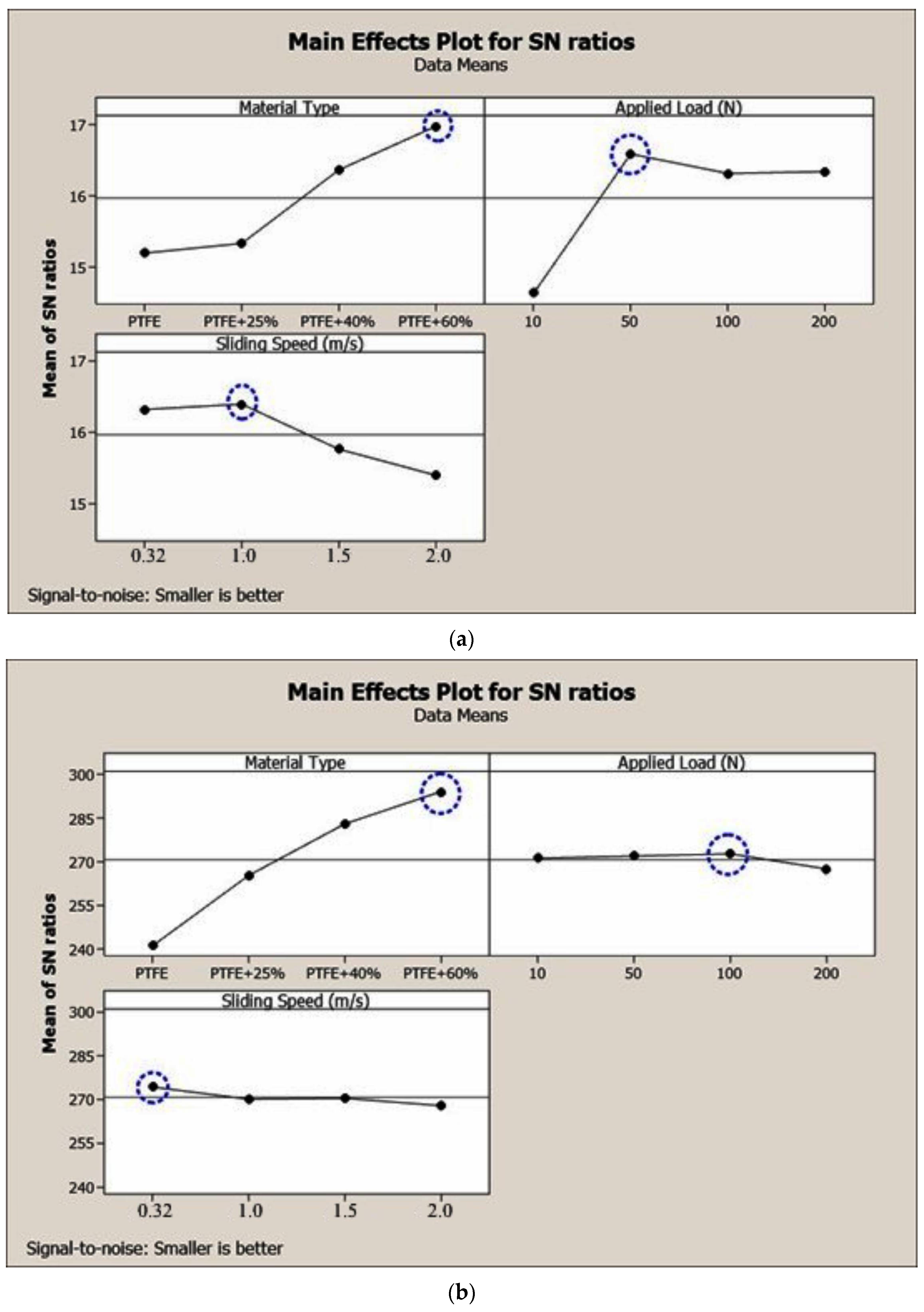
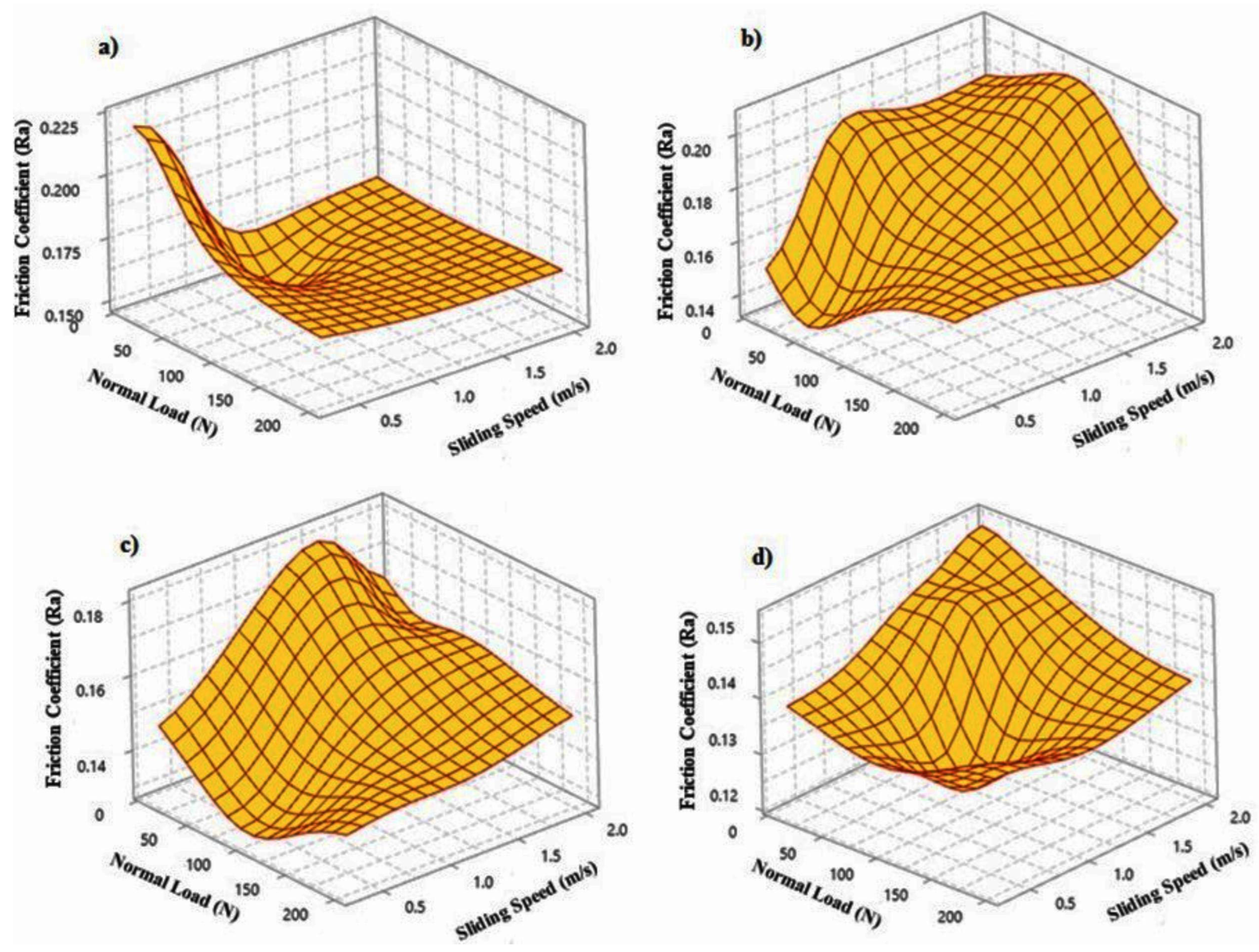

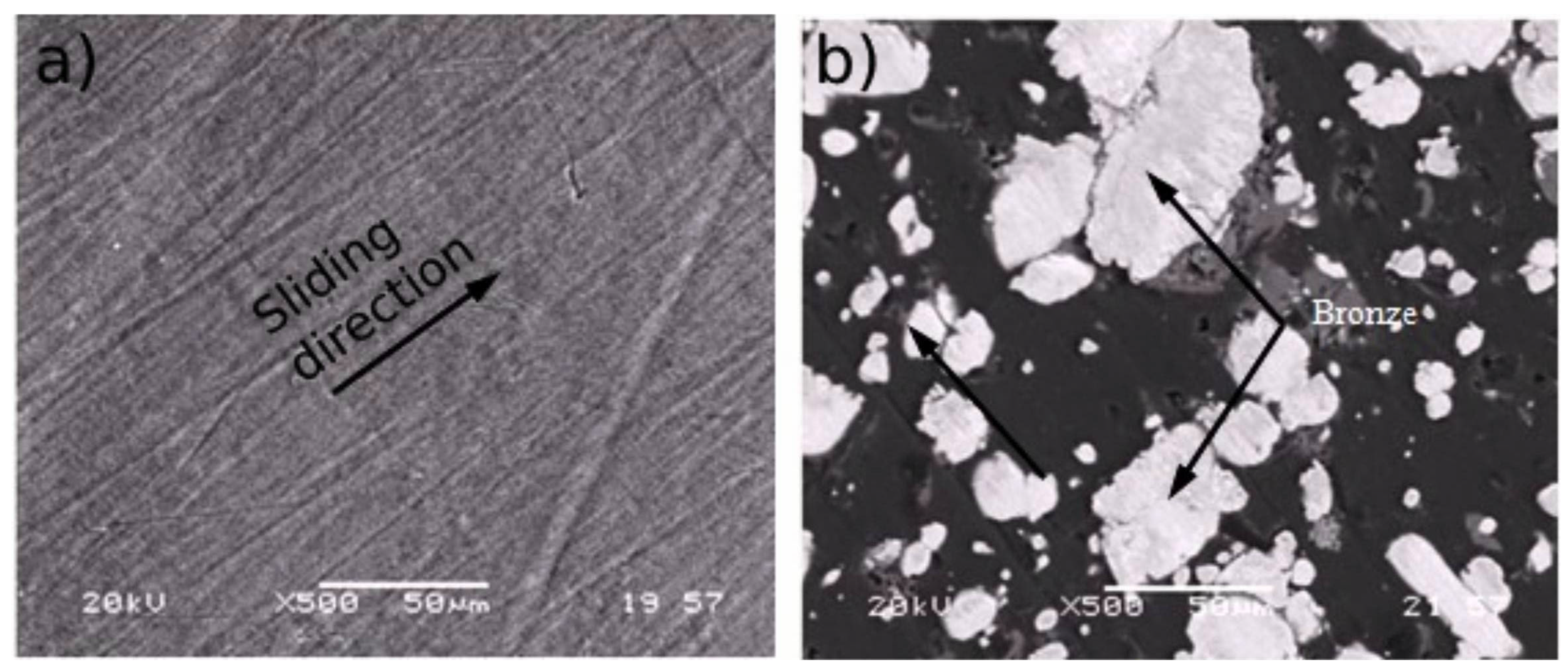
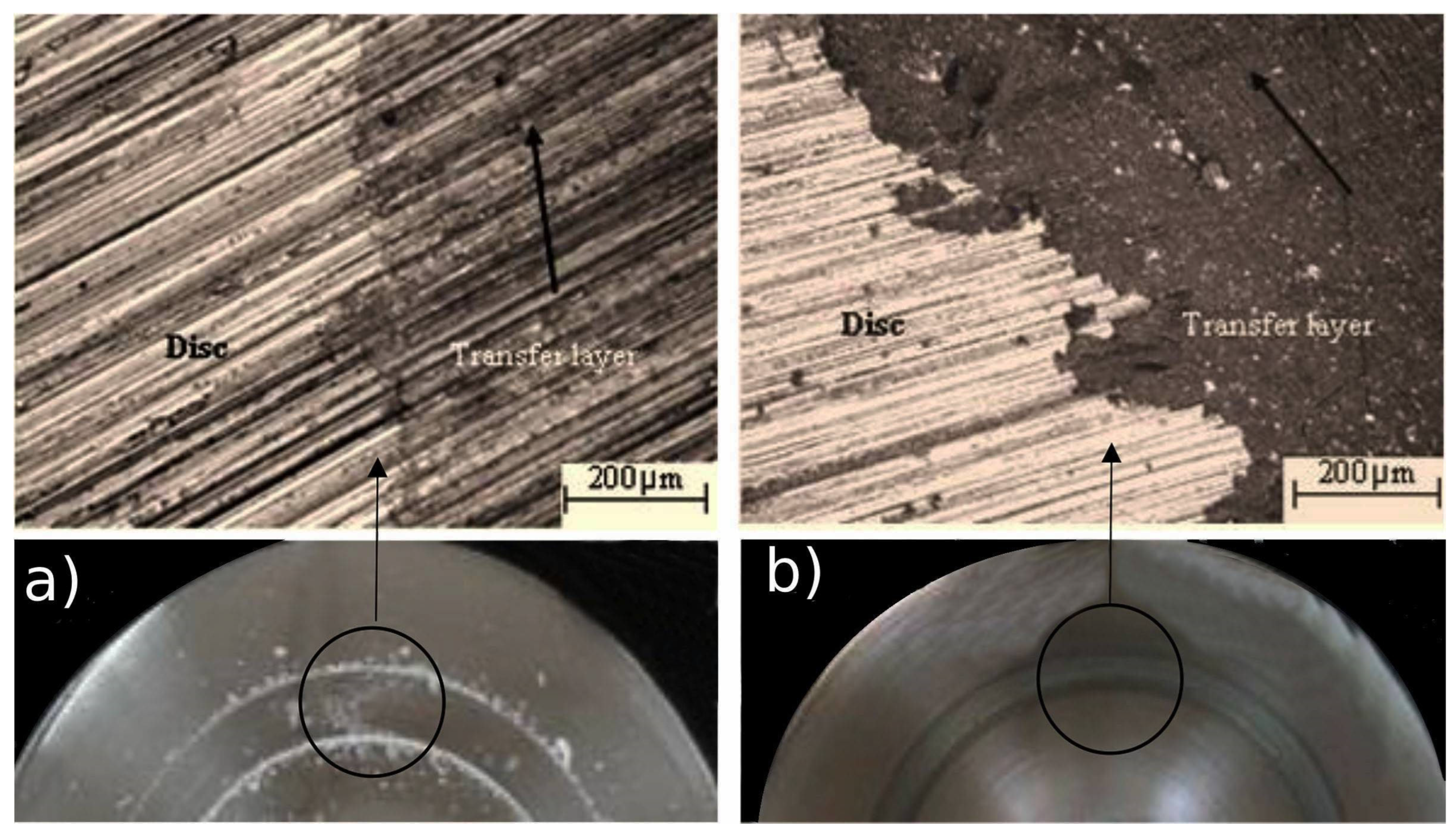
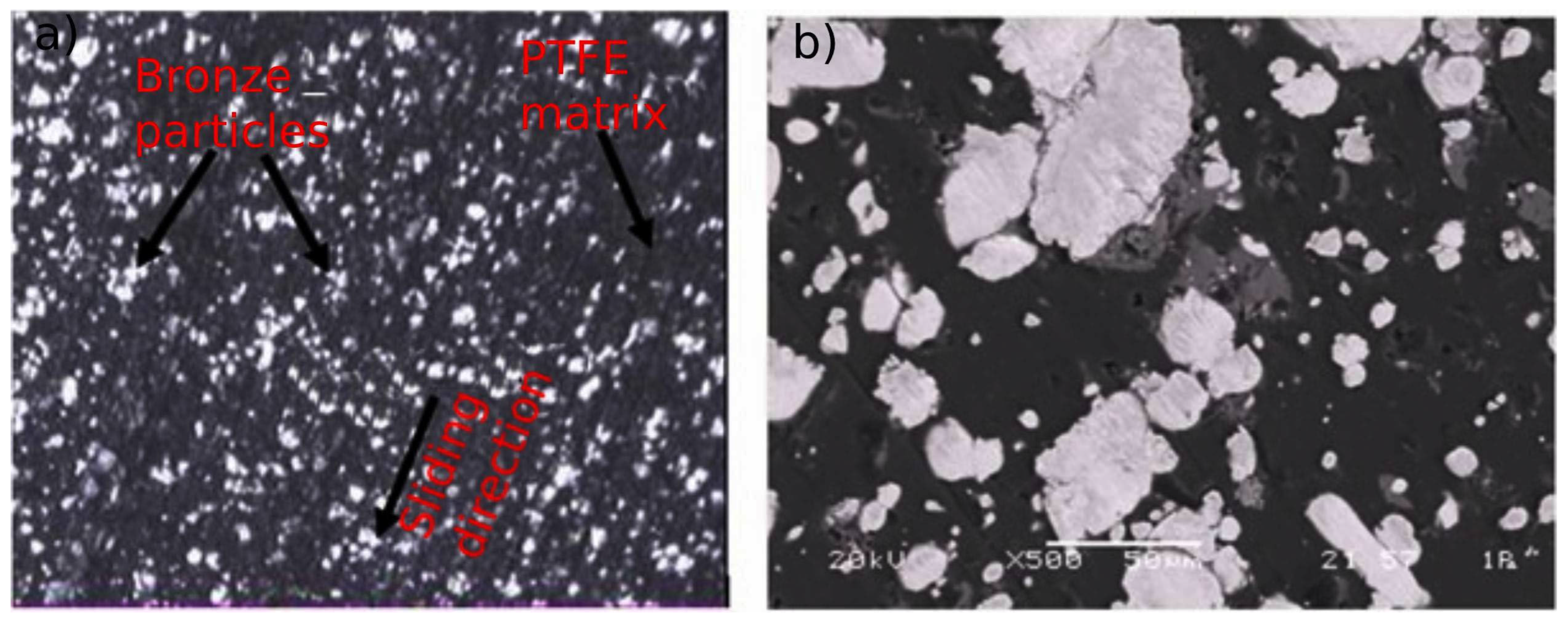
| Properties | Values |
|---|---|
| Tensile strength (MPa) | ≥7 |
| Elongation (%) | ≥50% |
| Density g/cm3 | 2.16–2.20 |
| Usage temperature °C | 200–250 |
| Properties | Values |
|---|---|
| Density g/cm3 | 2.5–3.20 |
| Hardness HRB | 112–114 |
| Grain size (µm) | <63 |
| Hot pressing range (°C) | 460–580 |
| Element | C | Si | Mn | P | S | Cr | Mo | Ni |
|---|---|---|---|---|---|---|---|---|
| Content | 0.98 | 1.2 | 0.8 | 0.040 | 0.30 | 17 | 0.70 | 0.80 |
| Materials | Colors | Density (g/cm−3) | Test Temperature (°C) | Relative Humidity (%) |
|---|---|---|---|---|
| PTFE | white | 2.14 | 21 ± 2 | |
| PTFE + 25 vol.% bronze | brown | 3.03 | 19 ± 4 | 50 ± 8 |
| PTFE + 40 vol.% bronze | brown | 3.49 | 19 ± 4 | |
| PTFE + 60 vol.% bronze | brown | 3.91 | 19 ± 4 |
| L16 (45) Test | 1 | 2 | 3 | 4 | 5 |
|---|---|---|---|---|---|
| 1 | 1 | 1 | 1 | 1 | 1 |
| 2 | 1 | 2 | 2 | 2 | 2 |
| 3 | 1 | 3 | 3 | 3 | 3 |
| 4 | 1 | 4 | 4 | 4 | 4 |
| 5 | 2 | 1 | 2 | 3 | 4 |
| 6 | 2 | 2 | 1 | 4 | 3 |
| 7 | 2 | 3 | 4 | 1 | 2 |
| 8 | 2 | 4 | 3 | 2 | 1 |
| 9 | 3 | 1 | 3 | 4 | 2 |
| 10 | 3 | 2 | 4 | 3 | 1 |
| 11 | 3 | 3 | 1 | 2 | 4 |
| 12 | 3 | 4 | 2 | 1 | 3 |
| 13 | 4 | 1 | 4 | 2 | 3 |
| 14 | 4 | 2 | 3 | 1 | 4 |
| 15 | 4 | 3 | 2 | 4 | 1 |
| 16 | 4 | 4 | 1 | 3 | 2 |
| Level | |||||
|---|---|---|---|---|---|
| Test Parameters | Units | 1 | 2 | 3 | 4 |
| Material type | - | PTFE | PTFE + 25 vol.% bronze | PTFE + 40 vol.% bronze | PTFE + 60 vol.% bronze |
| Normal Load | (N) | 10 | 50 | 100 | 200 |
| Sliding Speed | (m/s) | 0.32 | 1.0 | 1.5 | 2.0 |
| Material Type | Normal Load (N) | Sliding Speed (m/s) | SWR (m2/N) | S/N Wear Rate (dB) | COF (µm) | S/N Friction Efficient (dB) |
|---|---|---|---|---|---|---|
| PTFE | 10 | 0.32 | 7.42 × 10−13 | 242.59 | 0.220 | 13.15 |
| PTFE | 50 | 1.00 | 7.20 × 10−13 | 242.85 | 0.150 | 16.48 |
| PTFE | 100 | 1.50 | 1.19 × 10−12 | 238.49 | 0.165 | 15.65 |
| PTFE | 200 | 2.00 | 1.03 × 10−12 | 239.74 | 0.168 | 15.49 |
| PTFE + 25 vol.% bronze | 10 | 1.00 | 5.06 × 10−14 | 265.92 | 0.195 | 14.20 |
| PTFE + 25 vol.% bronze | 50 | 0.32 | 3.24 × 10−14 | 269.79 | 0.136 | 17.33 |
| PTFE + 25 vol.% bronze | 100 | 2.00 | 5.69 × 10−14 | 264.90 | 0.205 | 13.76 |
| PTFE + 25 vol.% bronze | 200 | 1.50 | 1.01 × 10−13 | 259.91 | 0.158 | 16.03 |
| PTFE + 40 vol.% bronze | 10 | 1.50 | 4.35 × 10−15 | 287.23 | 0.180 | 14.89 |
| PTFE + 40 vol.% bronze | 50 | 2.00 | 1.20 × 10−14 | 278.42 | 0.157 | 16.08 |
| PTFE + 40 vol.% bronze | 100 | 0.32 | 2.99 × 10−15 | 290.49 | 0.130 | 17.72 |
| PTFE + 40 vol.% bronze | 200 | 1.00 | 1.70 × 10−14 | 275.39 | 0.145 | 16.77 |
| PTFE + 60 vol.% bronze | 10 | 2.00 | 3.70 × 10−15 | 288.64 | 0.154 | 16.25 |
| PTFE + 60 vol.% bronze | 50 | 1.50 | 1.53 × 10−15 | 296.31 | 0.150 | 16.48 |
| PTFE + 60 vol.% bronze | 100 | 1.00 | 1.50 × 10−15 | 296.48 | 0.124 | 18.13 |
| PTFE + 60 vol.% bronze | 200 | 0.32 | 1.87 × 10−15 | 294.56 | 0.140 | 17.08 |
| Level | Material Type | Normal Load (N) | Sliding Speed (m/s) |
|---|---|---|---|
| 1 | 15.19 | 14.62 | 16.32 |
| 2 | 15.33 | 16.59 | 16.40 |
| 3 | 16.37 | 16.32 | 15.76 |
| 4 | 16.98 | 16.34 | 15.40 |
| Delta | 1.79 | 1.97 | 1.00 |
| Rank | 2 | 1 | 3 |
| Level | Material Type | Normal Load (N) | Sliding Speed (m/s) |
|---|---|---|---|
| 1 | 240.90 | 271.10 | 274.40 |
| 2 | 265.10 | 271.80 | 270.20 |
| 3 | 282.90 | 272.60 | 270.50 |
| 4 | 294.00 | 267.40 | 267.90 |
| Delta | 53.10 | 5.20 | 6.40 |
| Rank | 1 | 3 | 2 |
| Source | Degrees of Freedom (DOF) | Sum of Squares (SDQ) | Variance (V) | FTest | FTable | Percentage of Contribution (%) |
|---|---|---|---|---|---|---|
| Material type | 3 | 8.797 | 2.932 | 4.15 | 3.29 a | 29.83 |
| Normal load (N) | 3 | 9.834 | 3.278 | 4.41 | 3.29 a | 33.34 |
| Sliding speed (m/s) | 3 | 2.696 | 0.899 | 0.66 | 9.14 | |
| Error | 6 | 8.168 | 1.361 | |||
| Total | 15 | 29.494 |
| Source | Degrees of Freedom (DOF) | Sum of Squares (SDQ) | Variance (V) | FTest | FTable | Percentage of Contribution (%) |
|---|---|---|---|---|---|---|
| Material type | 3 | 6435.95 | 2145.32 | 119.72 | 12.92 a | 96.16 |
| Normal load (N) | 3 | 63.56 | 21.19 | 1.18 | 0.95 | |
| Sliding speed (m/s) | 3 | 85.69 | 28.56 | 1.59 | 1.28 | |
| Error | 6 | 107.51 | 17.92 | |||
| Total | 15 | 6692.71 |
| Materials | Response | Developed Mathematical Models | R2 (%) |
|---|---|---|---|
| Pure PTFE | COF | 15.3388 + 0.00630148 × N − 0.591276 × V | 93.3 |
| PTFE + 25 vol.% Bronze | COF | 15.4754 + 0.00630148 × N − 0.591276 × V | 93.3 |
| PTFE + 40 vol.% Bronze | COF | 16.5129 + 0.00630148 × N − 0.591276 × V | 93.3 |
| PTFE + 60 vol.% Bronze | COF | 17.1295 + 0.00630148 × N − 0.591276 × V | 93.3 |
| Pure PTFE | VSWR | 247.006 − 0208401 × N − 3.49497 × V | 97.8 |
| PTFE + 25 vol.% Bronze | VSWR | 271.216 − 0.0208401 × N − 3.49497 × V | 97.8 |
| PTFE + 40 vol.% Bronze | VSWR | 288.968.006 − 0.0208401 × N − 3.49497 × V | 97.8 |
| PTFE + 60 vol.% Bronze | VSWR | 300.083 − 0.0208401 × N − 3.49497 × V | 97.8 |
| Optimal Wear Test Condition | |||
|---|---|---|---|
| Predicted | Observed | Difference | |
| Levels | A4B2C2 | A4B2C2 | |
| S/N ratio for µ (dB) | 18.03 | 17.72 | 0.31 |
| Levels | A4B3C1 | A4B3C1 | |
| S/N ratio for SWR (dB) | 299.54 | 298.02 | 1.52 |
Disclaimer/Publisher’s Note: The statements, opinions and data contained in all publications are solely those of the individual author(s) and contributor(s) and not of MDPI and/or the editor(s). MDPI and/or the editor(s) disclaim responsibility for any injury to people or property resulting from any ideas, methods, instructions or products referred to in the content. |
© 2024 by the authors. Licensee MDPI, Basel, Switzerland. This article is an open access article distributed under the terms and conditions of the Creative Commons Attribution (CC BY) license (https://creativecommons.org/licenses/by/4.0/).
Share and Cite
Ficici, F.; Ozdemir, I.; Grund, T.; Lampke, T. Investigation of Tribological Behavior of PTFE Composites Reinforced with Bronze Particles by Taguchi Method. J. Compos. Sci. 2024, 8, 398. https://doi.org/10.3390/jcs8100398
Ficici F, Ozdemir I, Grund T, Lampke T. Investigation of Tribological Behavior of PTFE Composites Reinforced with Bronze Particles by Taguchi Method. Journal of Composites Science. 2024; 8(10):398. https://doi.org/10.3390/jcs8100398
Chicago/Turabian StyleFicici, Ferit, Ismail Ozdemir, Thomas Grund, and Thomas Lampke. 2024. "Investigation of Tribological Behavior of PTFE Composites Reinforced with Bronze Particles by Taguchi Method" Journal of Composites Science 8, no. 10: 398. https://doi.org/10.3390/jcs8100398








